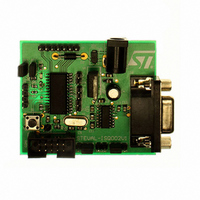STEVAL-ISQ002V1 STMicroelectronics, STEVAL-ISQ002V1 Datasheet - Page 29

STEVAL-ISQ002V1
Manufacturer Part Number
STEVAL-ISQ002V1
Description
BOARD EVAL BASED ON ST72264G1
Manufacturer
STMicroelectronics
Specifications of STEVAL-ISQ002V1
Main Purpose
Interface, PMBus
Embedded
Yes, MCU, 8-Bit
Utilized Ic / Part
ST72F264
Primary Attributes
The PMBus™ Interface Using the ST7 I2C Peripheral
Secondary Attributes
Firmware in C Language
Product
Power Management Modules
Lead Free Status / RoHS Status
Lead free / RoHS Compliant
Other names
497-6423
Available stocks
Company
Part Number
Manufacturer
Quantity
Price
Company:
Part Number:
STEVAL-ISQ002V1
Manufacturer:
STMicroelectronics
Quantity:
1
INTERRUPTS (Cont’d)
Servicing Pending Interrupts
As several interrupts can be pending at the same
time, the interrupt to be taken into account is deter-
mined by the following two-step process:
– the highest software priority interrupt is serviced,
– if several interrupts have the same software pri-
Figure 17
Figure 17. Priority Decision Process
When an interrupt request is not serviced immedi-
ately, it is latched and then processed when its
software priority combined with the hardware pri-
ority becomes the highest one.
Note 1: The hardware priority is exclusive while
the software one is not. This allows the previous
process to succeed with only one interrupt.
Note 2: RESET and TRAP are non-maskable and
they can be considered as having the highest soft-
ware priority in the decision process.
Different Interrupt Vector Sources
Two interrupt source types are managed by the
ST7 interrupt controller: the non-maskable type
(RESET and TRAP) and the maskable type (exter-
nal or from internal peripherals).
Non-Maskable Sources
These sources are processed regardless of the
state of the I1 and I0 bits of the CC register (see
Figure
registers (except for RESET), the corresponding
vector is loaded in the PC register and the I1 and
I0 bits of the CC are set to disable interrupts (level
ority then the interrupt with the highest hardware
priority is serviced first.
PRIORITY SERVICED
HIGHEST HARDWARE
16). After stacking the PC, X, A and CC
Same
describes this decision process.
INTERRUPTS
SOFTWARE
PRIORITY
PENDING
HIGHEST SOFTWARE
PRIORITY SERVICED
Different
3). These sources allow the processor to exit
HALT mode.
■
This software interrupt is serviced when the TRAP
instruction is executed. It will be serviced accord-
ing to the flowchart on
■
The RESET source has the highest priority in the
ST7. This means that the first current routine has
the highest software priority (level 3) and the high-
est hardware priority.
See the RESET chapter for more details.
Maskable Sources
Maskable interrupt vector sources can be serviced
if the corresponding interrupt is enabled and if its
own interrupt software priority (in ISPRx registers)
is higher than the one currently being serviced (I1
and I0 in CC register). If any of these two condi-
tions is false, the interrupt is latched and thus re-
mains pending.
■
External interrupts allow the processor to exit from
HALT low power mode.
External interrupt sensitivity is software selectable
through the Miscellaneous registers (MISCRx).
External interrupt triggered on edge will be latched
and the interrupt request automatically cleared
upon entering the interrupt service routine.
If several input pins of a group connected to the
same interrupt vector request an interrupt simulta-
neously, the interrupt vector will be serviced. Soft-
ware can read the pin levels to identify which
pin(s) are the source of the interrupt.
If several input pins are selected simultaneously
as interrupt source, these are logically NANDed.
For this reason if one of the interrupt pins is tied
low, it masks the other ones.
■
Usually the peripheral interrupts cause the MCU to
exit from HALT mode except those mentioned in
the “Interrupt Mapping” table.
A peripheral interrupt occurs when a specific flag
is set in the peripheral status registers and if the
corresponding enable bit is set in the peripheral
control register.
The general sequence for clearing an interrupt is
based on an access to the status register followed
by a read or write to an associated register.
Note: The clearing sequence resets the internal
latch. A pending interrupt (i.e. waiting for being
serviced) will therefore be lost if the clear se-
quence is executed.
TRAP (Non Maskable Software Interrupt)
RESET
External Interrupts
Peripheral Interrupts
ST72260Gx, ST72262Gx, ST72264Gx
Figure 16
as a TLI.
29/172




















